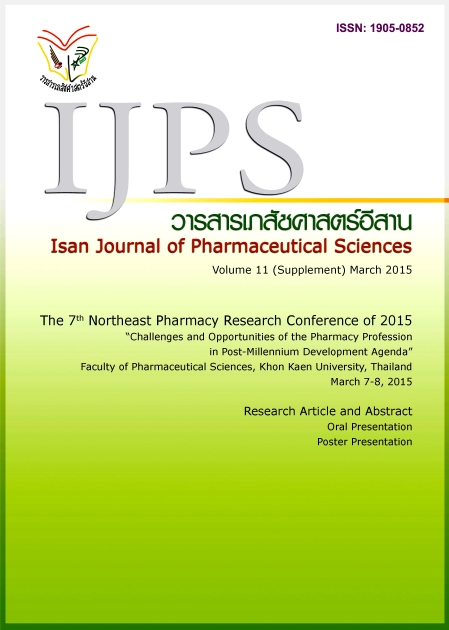Antioxidant activity and total phenolics of herbal extract of combination from mulberry leaves, turmeric rhizome, lakoocha’s wood and shiitake.
Main Article Content
Abstract
Introduction: The aimed of study to determine and compare antioxidant activity and total phenolics of herbal extracts combinationfrom 4 plantsincluding mulberry leaves, turmeric rhizome, lakoocha's wood and shiitake. Methods: Antioxidant activity testing methods by DPPH assay and total phenolic compound were performed. Results: From antioxidant activity by DPPH assay, Lakoocha's wood showed the best activity withIC50 was 18.32 ± 0.005 μg / ml and TPC was 2,493.32 ± 0.260 mg GAE / g sample. In the mixture of 2 plant extracts from mixture A (mulberry leaves and turmeric rhizome) showed the best antioxidant by DPPH assay which IC50 was 0.076 ± 0.007 μg/ml. The concentration of each plant in mixture A was 2.6 times lower thaneach single extracts and TPC of mixture A was 445,635.39 ± 0.008 mg GAE/g sample which is higher than TPC of single mulberry leaves extract and turmeric rhizome extract. The study of the relation with the Pearson’s Correlation between TPC and antioxidant activity showed statistically significant (p-value <0.001). Conclusion: This study showed that using herbal extracts combination could provide higher antioxidant activity than single plant extract. The combination of the suitable plants and optimized concentration could make the best synergistic effects. Therefore, using plant extract combination should be more advantage for the development natural health product in the near future.
Article Details
In the case that some parts are used by others The author must Confirm that obtaining permission to use some of the original authors. And must attach evidence That the permission has been included
References
Bandna, D., Neha, S., Dinesh, K. and Kamal, J. (2013). Morus alba Linn: Aphytopharmacological review. International Journal of Pharmacy and Pharmaceutical Sciences. ISSN- 0975-1491.
Burun Phansawan. (2013). Free radicals, Antioxidants, and Antioxidants Activity Determination. Journal of Science and Technology. 21/3. July- September.
Huang, W., Kim, J.S. and Chung, H.Y. (2011) Antioxidant activity and total phenolic content in shiitake mycelial exudates. Retrieved November,1 2014, from http://www.ncbi.nlm.nih.gov/pubmed/81542321#
Lee, W.C., et al. (2011). Antioxidant and antityrosinase activity of mulberry Morusalba L. (twigs and root bark), Food and Chemical Toxicology. 49, 785- 790.
Liu F, Ooi VEC, Fung MC. (1999). Analysis of immunomodulating cytokine mRNAs in the mouse induced by mushroom polysaxxharides. Life Sci. 64: 1005-1011.
Nasapon, P., Ampai, P., Maitree, S. and Pimporn, L. (2010). Antiglycation and antioxidant activities of oxyresveratrol extracted from the heartwood of Artocarpuslakoocha Roxb. Maejo Int. J. Sci. Technol. 4(03), 454-461.
Tem Samitina. (n.d.). Lakoocha's wood. Plant Genetic Conservation Project. Retrieved November,5 2014, from http://www.rspg.or.th/plants_data/herbs/herbs_04_5.htm
Sang, U.C., Young, M.K., Yun, J.P., Buk, G.H., Yong, S.P. and Shela, G., (2009). Antioxidant and antiproliferative effects of methanol extracts from raw and fermented parts of mulberry plant (Morusalba L.). Eur Food Res Technol. 230:231–237.
Singh, G., et al. (2010). Comparative study of chemical composition and antioxidant activity of fresh and dry rhizomes of turmeric (Curcuma longa Linn.). Food and Chemical Toxicology 48.1026– 1031.
Somjai Kajorncheappunngam. (2006). The Effect of Temperature, Time and Solvent on an Extraction of Curcumin from turmeric. KKU Engineering Journal. Vol. 33 No. 3 (225-236)
May – June
Song, H.B. and Hyung,. J.S. (2007). Antioxidant activities of five different mulberry cultivars in Korea. Sciencedirect. LWT 40.955–962.
Wasim, A., Azhar, H., Abdullah, A. and Tahera, T. (2010). Curcuma longa linn. A Review. Hippocratic Journal of Unani Medicine.Vol.5 No4. (179-190).


